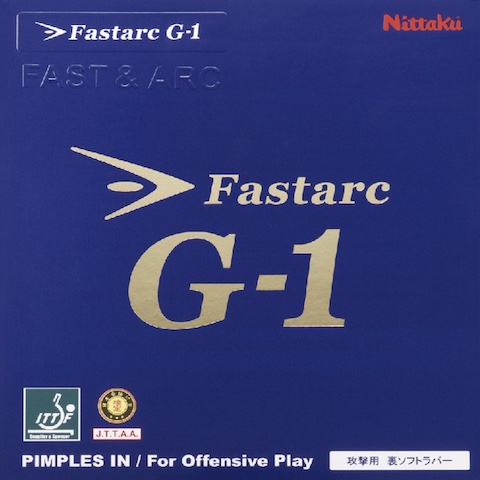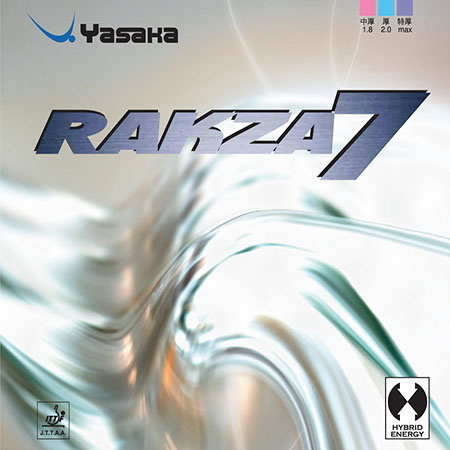Nittaku Fastarc G1 vs. Yasaka Rakza 7 Test
Two of the most highly regarded rubbers in the market are the Nittaku Fastarc G1 and Yasaka Rakza 7. In this article, we will dive into their features including speed, spin, control, sponge hardness as well as their advantages and disadvantages. Additionally, we will also examine their softer counterparts, the Nittaku Fastarc C1 and Yasaka Rakza 7 Soft, and recommend which type of player each of these rubbers would be best suited for.

Fastarc G1 vs. Rakza 7 | Rubber Comparison Test
Nittaku Fastarc G1

The Nittaku Fastarc G1 is a fast rubber that provides high power and speed. It has a strong but linear catapult effect (what is linear catapult?), which generates extra spin and speed to outmaneuver opponents. However, as Fastarc G1's sponge is a bit harder than most medium sponges (we would categorize it in the medium-hard section), you will need to hit the ball a little harder than with softer sponges which requires additional skill and experience but if you can manage to pull this off, you will be rewarded with the ability to fire absolute rockets at your opponent. However, if this is a playing style you struggle with, you might want to try out Nittaku Fastarc C1 which is a little bit softer and therefore requires less effort to activate the catapult.

Our all-time favorite, the Nittaku Fastarc G1, is made from a combination of top-quality natural and synthetic materials, and its sponge hardness of 47.5 degrees makes it slightly harder than the Yasaka Rakza 7. This balance of control and power results in a harmonious playing experience. The main advantage of the Nittaku Fastarc G1 is its high speed, spin and control making it an excellent choice for players who want to overpower their opponents. Other than extremely springy rubbers like Butterfly Tenergy 05, the Nittaku Fastarc G1 doesn't have the characteristic of letting the ball jump off the racket too fast and unexpectedly. Some tensor rubbers with non-linear catapult effect make it difficult to predict how hard you need to hit the ball, especially in the short game when doing pushes. With Fastarc G1, this is no problem because this rubber never lets the ball jump off the racket in an unexpected way. The main drawback of the Nittaku Fastarc G1 is that a certain skill level is required to activate all its power as mentioned earlier in this article. Also, we did notice that the G1 is very sensitive to incoming sping due to its grippy topsheet. This might be a problem for players who struggle with spinny serves from the opponent.
Yasaka Rakza 7

Yasaka is a Japanese company that has been producing high-quality table tennis equipment for over 90 years. With a strong commitment to performance and innovation, Yasaka was one of the leading brands in the 90s and especially their top seller rubber Mark V was widely used by players around the world, especially in Sweden which is one of Yasaka's key markets, and the company has a long-standing relationship with the Swedish table tennis community. Yasaka has sponsored and supported many of Sweden's top players, helping them to achieve success on the international stage. One of the most notable examples of Yasaka's relationship with Swedish players was Jan-Ove Waldner. Waldner, widely regarded as one of the greatest table tennis players of all time, used Yasaka equipment throughout his career and helped to popularize the brand in Sweden. Today, Yasaka is supporting players like Double World Champion Mattias Falck who is using both, blade and rubbers, from Yasaka.
The Yasaka Rakza 7 is known for its outstanding balance of speed, spin and control. This rubber is made from a mixture of natural and synthetic materials, and its sponge hardness of 46 degrees makes it only barely softer than Fastarc G1. It has a decent, but not overwhelming catapult effect as well, providing ample power to put your opponent under pressure without compromising too much in the aspect of control. This is immediately noticeable when bouncing the ball on the bat. With the Rakza 7 you always get a very linear, controllable bounce without having the ball shooting off too high.
Differences in speed, spin and control
When it comes to speed, both the Nittaku Fastarc G1 and Yasaka Rakza 7 are fast, making them excellent options for players who prefer an energetic style of play. However, the Nittaku Fastarc G1 is slightly faster, making it an excellent choice for players who are looking to maximize their speed and power. In terms of spin, both rubbers perform exceptionally well but again, it's the Fastarc G1 which generates more rotation on the ball. In terms of control, we do see Rakza 7 leading in this area due to a less springy sponge which helps to keep the ball on the table. Overall, the Nittaku Fastarc G1 is slightly faster, which may make it a bit harder to control for players who are not used to playing with fast rubbers. However, its high quality materials and slightly harder sponge (47.5 degrees) provide good stability, making it suitable for skilled players looking to maximize their speed and power. When it comes to spin sensivity to incoming spin, Rakza 7 has a slight advantage here compared to Fastarc G1 because the Yasaka rubber's topsheet is just ever so slightly less grippy and bouncy compared to its Nittaku pendant. This characteristic allows players using Rakza 7 to be a bit less vulnerable to tricky serves while Fastarc G1 users will struggle against strong, incoming spin. However, when looking at the offensive side, Fastarc G1 can generate more spin which can be very useful when opening up with a topspin loop against heavy underspin. Once you master this shot, the Fastarc G1 will make your opponents trying to desperately block your loops but overshooting the table regularly.
Which rubber for which skill level?
Both of these rubbers are suitable for players of intermediate to advanced skill levels, with the Yasaka Rakza 7 being a better option for players who need less power in their strokes, and the Nittaku Fastarc G1 being ideal for energetic players looking to maximize their speed and spin which makes this rubber also an option for semi-professionals and even fully professionals like world class player Mima Ito (JPN) who uses Fastarc G1 on her forehand while Rakza 7 is not being used by any of world's top table tennis professionals.
Rakza 7 – Skill level recommendation
- For intermediate and advanced players
- Good for offensive style close to table
- For players who value control over speed and power
Fastarc G1 – Skill level recommendation
- For intermediate, advanced and (semi-) professional players
- Great for fast mid-distance play and counter looping
- Can generate lots of spin and power when player puts in more effort
Summary: Main differences between Fastarc G1 and Rakza 7
- Fastarc G1 is a bit harder than Rakza 7
- Fastarc G1 requires more power to activate catapult effect
- Fastarc G1 has more top end speed than Rakza 7
- Fastarc G1 is best at counter looping from mid-distance
- Fastarc G1 is very sensitive to incoming spin
- Rakza 7 has more control than Fastarc G1
- Rakza 7 is better when playing close to the table
- Rakza 7 has less top end speed compared to Fastarc G1
- Rakza 7 is less sensitive to incoming spin that Fastarc G1
- Both are very similar in terms of spin and control
- Both are available at similar prices around $45
Softer alternatives: Fastarc C1 & Rakza 7 Soft
For players who prefer a softer touch and increased control, there are also the Nittaku Fastarc C1 and Yasaka Rakza 7 Soft available. Both of these rubbers are designed with a softer sponge and are ideal for developing players. Please keep in mind though that Fastarc C1's sponge at 43° is only slightly softer than Fastarc G1 (47.5°) while Rakza 7 Soft is extremely soft at 39° and therefore very different in terms of playing characteristics.
Check out our Best Tensor Rubbers 2024 list.

Also available: Butterfly Tenergy 05 vs. Fastarc G1 comparison
 Spin Testers
Spin Testers
